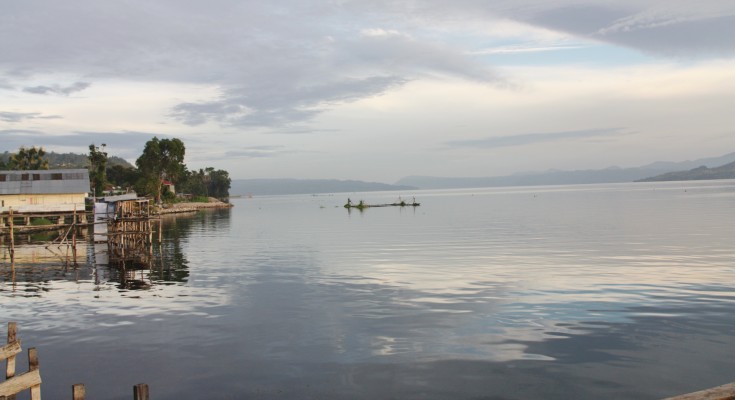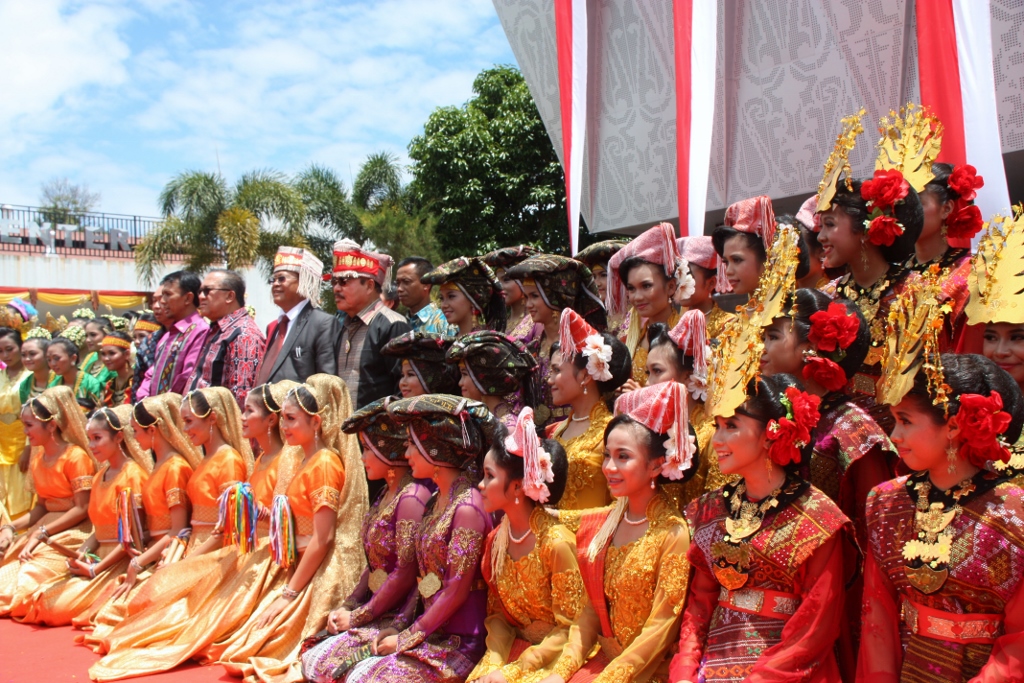Part 1 of 4 contributions on Lake Toba.
From Medan, the capital of North Sumatra, it is a 5 hour drive to the much cooler town of Balige (800 m above sea level) on beautiful Danau (Lake) Toba. We are invited for the Festival Danau Toba 2014 which will last 5 days. On the programme a.o. traditional music and dance of the Batak people, the indigenous inhabitants the majority of whom became Christians. The coming days people can enjoy the popular Batak opera; old rituals such as Mangalahat Horbo (Slaughter of the water buffalo) to ask for blessings, and sensational boat races with the solu bolon, long canoes.
Drinking good Sumatran coffee in the hazy morning we see these white, red and black decorated canoes lying on the shore next to the terrace of our hotel Ompu Herti. The three colours symbolize heaven (white), earth (red) and black (underworld). Approaching the festival area we see crowds of schoolgirls and schoolboys colourfully dressed for their dance performances. VIP’s arrive in cars with darkened windows. Kids present an ulos, a Batak ceremonial cloth for this occasion extended to 450 metres made in eight months by 20 weavers. They carry it completely unfolded to the place of the opening ceremony on the big square of Sisingamangaradja XII. A huge statue of this last king of the Toba Bataks overlooks the festival terrain. The legendary Batak hero was killed in the mountains around Balige in 1907 along with his two sons by the notorious Tiger Brigade of the colonial military police.
Long speeches are held, by the governor of North Sumatra, the vice minister for Tourism and the bupati, the regent, and by ex-lieutenant-general T.B. Silalahi. This prominent Batak is founder of the interesting Silalahi ethnological museum located at the background of the square. After a prayer of a muslim leader, accompanied by a catholic priest and a protestant reverend, the show starts. It’s a colourful event, all dancing groups are dressed differently representing the ethnic groups living in North Sumatra, such as Bataks, Acehnese, Javanese and Chinese. The dances are about warfare, including against the Dutch, stamping rice for the guerrillas, planting and harvesting and children’s plays. The final performance is an Acehnese dance by schoolgirls which is very exciting and energetic.
“We hope to raise the number of tourists to Indonesia to twenty million by 2020. So more than double the present number,” says Sapta Nirwandar, Vice Minister of Tourism and Creative Economy at the press conference. After Bali and Yogyakarta Lake Toba ranks number three as a major tourist destination in Indonesia. The beautiful landscape and interesting culture of the Bataks, consisting of 6 different groups, have a lot to offer. One of the questions, asked by a foreign journalist, deals with the tension between attracting tourists to Lake Toba on one hand and economic profits from big scale fish farming by a foreign company on the other hand. Fish are fed with antibiotics polluting the lake. The Vice-Minister mentions relocation of the platforms far away from the tourist places. Mr. Silalahi is very passionate about the issue of pollution which he repeatedly discussed with the national parliament and the Environment Ministry. According to him relocation is not a solution. He fears that if nothing is done and if industrial fish farming continues the lake will turn into a swamp and swimming in the lake will be completely impossible.
Let’s hope steps will be taken in time so that beautiful Danau Toba will survive for the next generations to come!
With thanks to the Department of Tourism and Creative Economy, Jakarta, Indonesia.
Willem van Gent was born in Rotterdam (1948) and lives in Amsterdam. He
was a social worker and communication manager. Now he enjoys photography
and writing travel stories. Travelled in Asia ( a.o. Indonesia, Taiwan,
India, Nepal, Laos, Cambodia, Timor Leste and Burma) and The Americas.
















